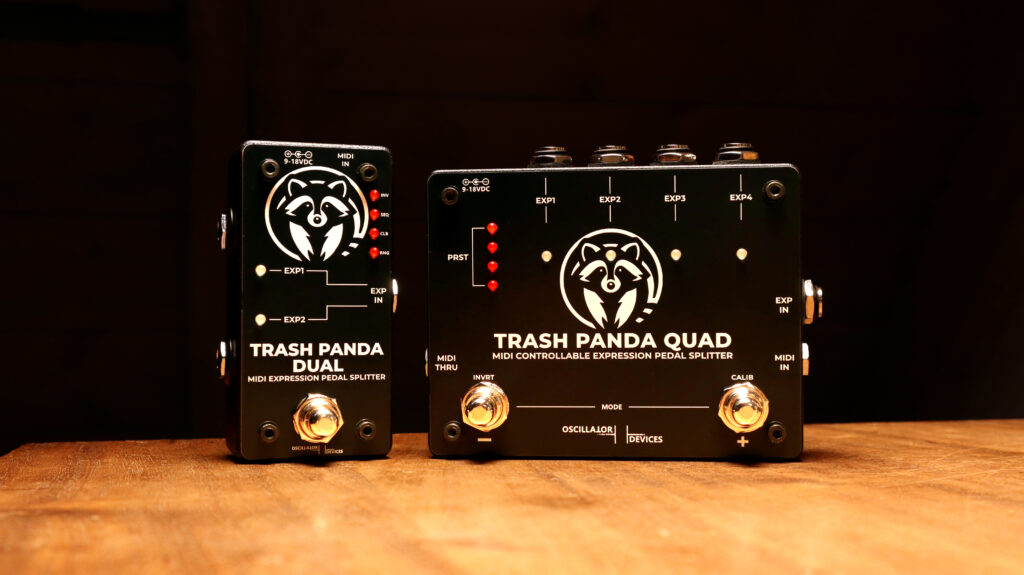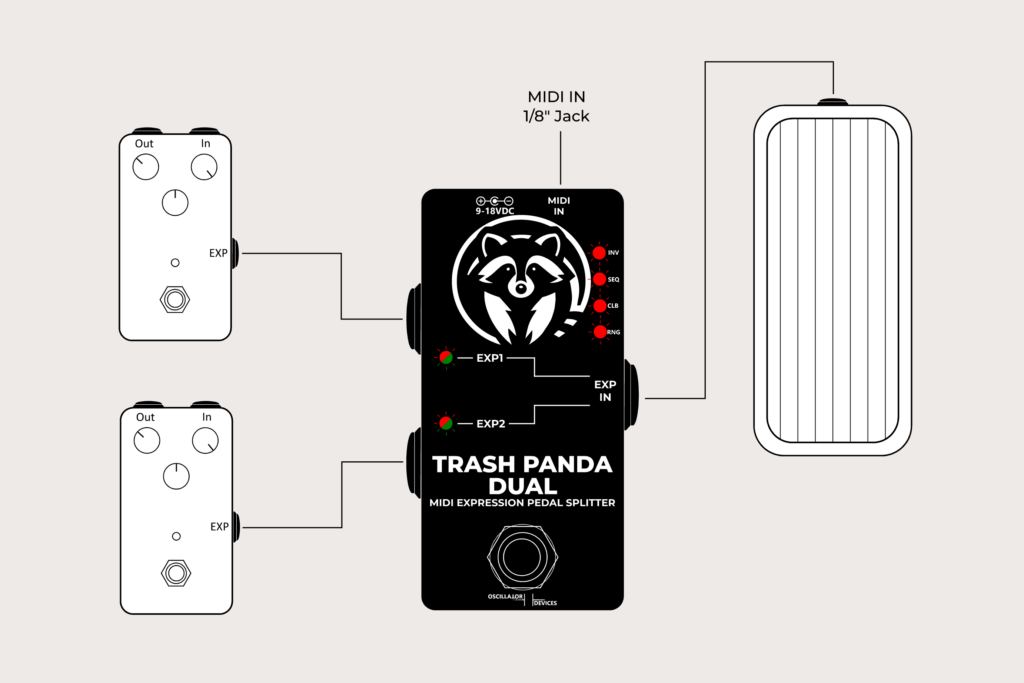The Oscillator Devices Trash Panda is a MIDI controllable expression pedal splitter. Plug in your expression pedal and control up to four effects devices with expression pedal or CV inputs. All functions are MIDI-controllable – even the pedal position of the expression outputs. That also makes it a MIDI-to-expression translator/converter. The expression outputs can also be internally controlled by a LFO that syncs to MIDI clock.
The expression outputs retain their last position when switching to another output. Even when reselecting an output, the value remains unchanged until the expression pedal is moved. This allows for easy switching between outputs while maintaining precise control over each parameter.
Features:
- Control up to four expression outputs with a single expression pedal
- MIDI control of all functions
- All expression outputs can act as 5V CV outputs
- Presets for controlling multiple ouputs simultaneously with various tapers (Quad only)
- Adjustable output range for each expression output (Dual only)
- Inverting the expression direction
- Expression pedal calibration
- LFO waveforms to modulate the expression outputs
- Selectable MIDI channel
- Compatible with all MIDI 1.0-compliant controllers
- High-quality Amphenol and Neutrik sockets
- Developed and hand-built by Oscillator Devices in Germany

Differences between the models
| Outputs | EXP Input | MIDI Thru | Adj. Range | Dimensions* | |
| Dual | 2 | Yes | No | Yes | 100 x 50 x 31 mm |
| Quad | 4 | Yes | Yes | No | 119 x 94 x 34 mm |
*Dimensions of the enclosure without sockets and switches
Trash Panda Quad – Quad Expression Splitter Overview
The Trash Panda Quad features four expression outputs that can be controlled simultaneously via an expression pedal and MIDI.
With the two footswitches, you can cycle through the four expression outputs and select which one is currently controlled by the connected expression pedal. Alternatively, you can load one of the 8 user presets to control any combination of outputs at once. Each output can also have its heel and toe positions individually inverted for maximum flexibility.
Of course the Trash Panda Quad can be used as standalone MIDI device – no expression pedal required. Every expression output can be controlled individually by MIDI CC commands or modulated by the built-in LFO waveforms.
Manual vs. Preset Mode
The Trash Panda Quad offers two main operating modes: Manual Mode and Preset Mode.
Manual Mode is straightforward. Use the footswitches to cycle through the expression outputs. Unused outputs are automatically skipped, allowing for quick selection when fewer than four outputs are in use. Each output can be individually inverted — swapping heel and toe positions — for more intuitive control. This mode is ideal for most users who want direct control over a single output at a time.
But what if you want to control multiple outputs simultaneously? That’s where Preset Mode comes in. In this mode, you can configure up to eight presets, each with different combinations of the four expression outputs, including inversion settings and logarithmic tapers. This makes it easy to recall complex setups with a single press or MIDI PC commands.
Trash Panda Dual – Dual Expression Splitter Overview
The Trash Panda Dual features two expression outputs that can be controlled simultaneously via an expression pedal and MIDI.

The single footswitch allows you to toggle between EXP1 and EXP2 — or, depending on your configuration, activate both outputs (EXP1+EXP2) or disable them entirely. As with the Quad version, each output can be individually inverted to swap heel and toe positions.
A unique feature of the Trash Panda Dual is its range control. This allows you to limit the output range individually for EXP1 and/or EXP2, setting distinct values for the heel and toe positions.
Expression Pedal Calibration
Not all expression pedals behave the same. While variations in potentiometer resistance are generally unproblematic, differences in output range can have a noticeable impact — especially with low-resistance pedals. In such cases, a required series resistor can shorten the usable range of the pedal.
To address this, both Trash Panda models include a calibration function. This allows you to easily adapt the device to your specific expression pedal, ensuring that you always get the full range of motion and precise control.
LFO-Waveforms
Just like the Garbage Collectors, the Trash Panda series features an internal LFO engine that syncs to MIDI clock. This engine offers three different waveforms — sine, square, and sawtooth (rising or falling) — which can be used to modulate the expression outputs via the MIDI-to-expression converter.
The speed of the LFO is determined by the MIDI clock, with one full cycle corresponding to whole, half, quarter, eighth, or sixteenth notes. To give you even more control, each waveform can be customized in terms of starting phase, amplitude, and position offset — allowing for expressive and rhythmic modulation tailored to your setup.

Expression vs. CV
Each output on the Trash Pandas can be individually switched between Expression and CV mode — but what’s the difference?
An expression pedal essentially acts as a passive potentiometer. In a typical setup, the device receiving the expression signal supplies a reference voltage (usually +5V or +3.3V) via the ring of the TRS connector. The pedal divides this voltage depending on its position, and the resulting voltage is sent back to the device via the tip.
A control voltage (CV) signal, by contrast, actively generates a voltage on the tip of the connector — it doesn’t rely on any voltage being supplied by the receiving device. This makes CV a fully active signal type, suitable for controlling synthesizers, modular gear, or any device that accepts standard 0–5V CV inputs.
Can’t I Just Use an ABY Pedal?
Whenever the question comes up about how to control multiple effects devices with a single expression pedal, someone inevitably suggests using an ABY switch instead of a dedicated expression pedal splitter. Unfortunately, that’s a common misconception — and potentially a harmful one.
Using an ABY pedal might work for the device currently connected to the expression pedal, particularly if the ABY is passive or true bypass. But what about the device that’s not currently connected? It often doesn’t behave correctly — it may jump to heel, snap to toe, or act erratically. Why? Because as long as a plug is inserted into the expression input, the effects device expects to receive a valid control voltage. Without it, the input might float unpredictably.
What about using the ABY in Y mode to control two pedals at once? In some cases, it might seem to work — if you’re lucky. But if the two pedals use different internal reference voltages (e.g. one supplies 3.3V, the other 5V), you risk creating a voltage mismatch, which can lead to unreliable behavior or even damage to one or both devices.
That’s why the Trash Panda exists — to safely and intelligently split and manage expression signals and CVs across multiple devices, with proper voltage handling, isolation, and control.
MIDI Connection
The MIDI sockets are assigned according to the official MIDI specification of MIDI TRS using MIDI TRS Type A, like pedals from Boss or Wampler. A 1/8″ (3.5 mm) stereo jack plug is used. The MIDI Thru socket is latency-free.

